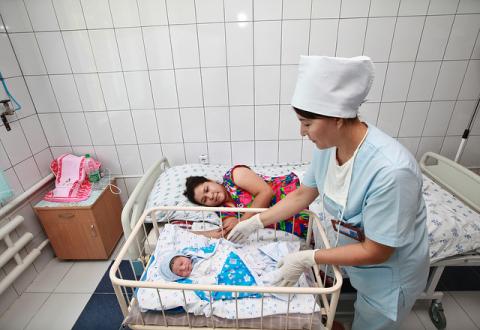Caregiving and influenza risk

Caregiving has traditionally been a female area, both domestically and in the workplace. Due to the nature of influenza, healthcare workers and those in close contact with young children are at a greater risk of exposure to influenza viruses, both seasonal outbreaks and pandemic strains (Zhang et al 2011). Studies have generally shown compliance rates from as low as 10% to 40-50% among healthcare workers, with no clear pattern to ascertain why this is (Tell Me 2012).
Women represent more than 50% of the healthcare workforce in many countries; also, in most countries nurses, teachers and childcare workers are mainly female (WHO 2010). For example, 80.2% of employees in the Irish health services are women, and women account for 92.1% of nurses (CSO 2013). Front-line workers face disproportionate risks of illness and death during a pandemic; Godderis and Rossiter (2013) argue that this increased risk of illness and death is an issue that is both moral and gendered, and therefore fundamentally social in its nature and not just a medical issue. Studies in Greece and Canada have found that male healthcare workers are more likely to have the intention to be vaccinated, and in Sicily to be vaccinated against H1N1 than female health-care workers (Bish et al 2011).
Another issue the responsibility for care giving in the home for both children and ill family members – this is a large risk factor for exposure to the influenza virus, and is a role predominantly occupied by women It has been shown that women who work outside the home have a lower risk of developing a viral illness, suggesting that societal roles such as childcare is a risk factor in acquiring influenza. In addition to this, caregivers may not be able to seek adequate treatment because of their caring responsibilities, thereby leading to delayed treatment (WHO 2010). Women’s care giving role often affects their workplace participation, which in turn contributes to poorer health in older age – also, women may not have been in the workforce long enough to accrue support in terms of for example retirement funds (Davidson et al 2011). Care giving thus creates a number of issues regarding vaccination, which affects women both at the time of an influenza infection and also potentially further on in the life course.
Bibliography
Bish, A., Yardley, L., Nicoll, A., and Michie, S. (2011) ‘Factors associated with uptake of vaccination against pandemic influenza: A systematic review’ Vaccine, 29(38), 6472-6484.
Central Statistics Office (2013) Women and Men in Ireland 2013, available: www.cso.ie/en/releasesandpublications/ep/p-wamii/womenandmeninireland201... [accessed 15 August 2014].
Davidson, P.M., DiGiacomo, M., and McGrath, S.J. (2011) ‘The feminization of aging: how will this impact on health outcomes and services?’ Health Care for Women International, 32(12), 1031-1045.
Godderis, R. and Rossiter, K. (2013) ‘”If you have a soul, you will volunteer at once”: gendered expectations of duty to care during pandemics’, Sociology of Health & Illness, 35(2), 304-308.
Tell Me (Transparent communication in Epidemics: Learning Lessons from experience, delivering effective Messages, providing Evidence) (2012) D1.7 Population behaviour in Epidemics Summary Report, Brussels: European Commission.
World Health Organisation (2010) Sex, gender and influenza, Geneva: World Health Organisation.
Zhang, J., While, A.E. and Norman I.J. (2011) ‘Nurses’ knowledge and risk perception towards seasonal influenza and vaccination and their vaccination behaviours: A cross-sectional survey’, International Journal of Nursing Studies, 48(10), 1281-1289.
